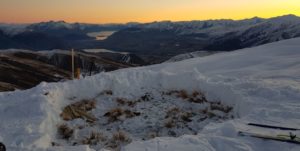Turk installation
Installing a Turk is the exciting culmination of a lot of hard work. To date there have been three “installation events” each using different equipment and Turk designs. The process typically uses expensive and dangerous equipment (i.e. heavy stuff dangling below a helicopter) hence working out a solution that is efficient, does not endanger people and ends in a good result is vital.
Outlined below is the evolution of different processes to install a Turk. The final installation was the most efficient and with a few minor improvements will be the install process of choice.
Typically my photos/filming of the install process is not very good because I am in the thick of it but hopefully this will give you an idea of what it involves.
Crown Basin
This was the first Turk built and the tank was bolted to a 50 x 200mm foundation frame in an attempt to flatten the plastic floor of the tank (a problem that has taken 3 iterations to solve).
A Squirrel B2 was used to fly two loads. The first comprising of 3 people (myself, Anton Schmitz and Brent Jarvis) with tools, the deck and toilet slung below the helicopter. While the helicopter returned for the Turk the three of us started digging frantically – the problem being the first of the winter snows had arrived 4 days before and we had to dig down to the ground. It was actually a little worse than that, I had skied to the site the day before from Cardrona (why I did the most difficult route possible I don’t know) arriving an hour before it got dark and wandered around with an avalanche probe trying to find the ideal location, then dug until it was dark and skied home for 4 hour in pitch blackness.

The install day had ideal flying conditions with not a breath of wind and good lighting to help the pilot judge the distance between to load and ground. The pilot lowered the Turk to remove wobble and spin then lifted again while the three of us positioned it to the correct location and rotation. With the Turk firmly on the ground we used a car jack to level the structure.
Overall the process worked well. The Squirrel was well suited to the load but it did strike me there was a lot of room for improvement. Such a large object weighing almost a ton (920 kg for that design) has a lot of momentum and combined with the difficulty of people moving on snow or tussock while the load pendulums about means that in windier conditions the chance of injury is quite real.
Cape Adare, Antarctica
At Cape Adare we were working with the Chinese from the Xue Long ice breaker and using a Russin Kamov 32 (ka-32) helicopter. This is a beast of a machine with a 4 ton lift capacity and consumes fuel like a Russian drinks vodka. While trying to work out a flight plan the Chinese suggested putting an extra two tons of gravel in the Turks because the machine’s optimum load was 3 tons and 1 ton was a bit light and would swing around. Unfortunately we weren’t able to do this because of the environmental rules, I’m also unsure whether the lifting lugs would have supported such weight.
The Cape Adare Turks were placed directly onto the gravel on the beach. The idea was to dig a slight hollow to accommodate the downward bulge of the Turks base and lower it into this hollow. The powerful helicopter lifting such a light load meant it swung around a lot and the Turks couldn’t be positioned with an accuracy better that 1.5 meters. It was hoped the Turks could be slid on the gravel but it was the wrong kind of gravel and they tended to dig in. Fortunately there were 25+ Chinese on hand to help move them into position.
Mid Dome
This design makes use of a square foundation frame and detachable deck. The idea being that the foundation frame, deck, toilet (total weigh < 300 kg) and 3-4 people can be flown in using Squirrel or similar helicopter. The foundation frame is positioned and leveled then the Turk is flown in and lowered onto the frame by the helicopter only (no ground crew trying to position it). With the Turk on a hard surface 2-3 people can push it into the correct position (a few levers can help), it is then bolted to the frame and the sub-floor space filled with bagged gravel.
The Mid Dome installation went very smoothly, a BK177 was used which has a similar lift capacity to a Squirrel. The deck and foundation and frame were flown in with 3 people + pilot and positioned on a pre-leveled site. The helicopter returned 15 minutes later with the Turk. After another 15 minutes of manual positioning the false floor was removed, bagged gravel installed and the floor re-installed.